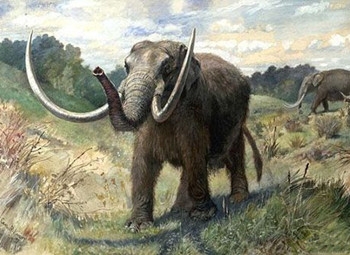
But despite their name, the mighty Everglades did not exist during the ice age. So what did pre-historic Florida look like? There is one place in northern Florida that has revealed more ice age secrets than almost anywhere else, the dark slow-moving waters of the Aucilla River. Here ideal conditions for fossilization created a hidden store of ice age evidence. Unlike in the crystal clear spring waters, these clues were never unveiled for all to see. But the Aucilla has now been studied intensively for more than 20 years.
尽管它的名字叫做“大沼泽地”,但是这片沼泽在冰河时代并不存在。那史前的佛罗里达到底什么模样?在佛罗里达北部的一个地区,我们能够发现比其他地方更多的冰河时代的痕迹。这就是尤喜拉河,在这里,幽暗的河水缓慢地流淌着。这里的环境极其适合化石的保存,因此这里储存着很多冰河时代的痕迹。和晶莹透亮的温泉不同,这些线索不会在众人面前一显真容。但如今尤喜拉河已经被人们深刻研究了20余年。
Along some stretches of the riverbed were massive bones recreated here, perfectly preserved for more than 13,000 years. One of the most significant discoveries was the huge skull of an American mastodon. Mastodons, close relatives of mammoths, were widespread all over North America during the ice age. They grew over three metres tall, the size of Africa elephants today. We know a lot about the mastodons, especially their diet, thanks to the preserved dung they left behind.
河床的沿岸能够发现很多巨大的骨骼化石,他们被完好地保存了13000多年。其中,最具标志性意义的发现之一就是一个巨大的美洲乳齿象头骨。乳齿象是猛犸象的近亲,在冰河时代,他们的足迹遍布整个北美。他们的身高可达到3米,和现在的美洲大象体型相当。我们对乳齿象了解颇深,尤其是他们的饮食,这是因为他们留下的粪便保存良好。
英文文本来自普特英语,译文属可可原创,仅供学习交流使用,未经许可不得转载。











